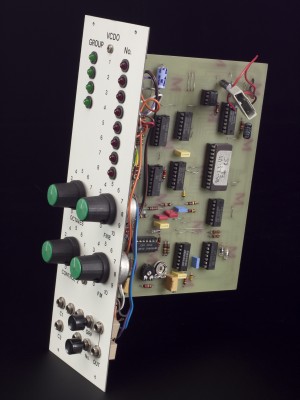One of the most interesting objects in our Oramics to Electronica exhibition is a home-built synthesiser module. This incredible object (donated by the museum’s very own Tim Boon) clearly shares a heritage with the ingenious D.I.Y instruments created by ground-breaking electronic fiddlers, solderers and tweakers such as Daphne Oram.
 However, the object is also extremely significant because it shows that home-made electronic music existed long before Fruity Loops software came along in 1998.
However, the object is also extremely significant because it shows that home-made electronic music existed long before Fruity Loops software came along in 1998.
A similar painstakingly crafted and incredibly complex home-built synthesiser recently went on display at the Massachusetts Institute of Technology’s museum.
Dr. Joseph Paradiso’s analogue synthesiser, which he has described as “probably the world’s largest homemade modular synthesiser”, was created over more than ten years using “information from manufacturers’ data sheets and hobbyist magazines”, scrounged spare parts and hacked keyboards. For years the instrument took over Paradiso’s living room, replacing couches and coffee tables with wires, processors, knobs and complex logic modules.
However, Paradiso’s synthesiser has now taken on a new virtual life: the synthesiser is attached to an online interface that enables you to control it in real-time from anywhere in the world.
Thanks to the programme Patchwerk, Paradiso’s synthesiser can be controlled and modified from your internet browser, with the results streamed back to you and everyone else around the world that is logged in to the site and listening to the live stream.
The project offers an extremely fun and interesting way to engage with what is otherwise one of the more intimidating and less user-friendly types of electronic instruments – analogue synthesisers.
What’s more, the instrument is an unusual merger of two of the most significant developments in the democratisation of electronic music: home-made synthesisers and computer-based emulators and virtual interfaces. Home-made synthesisers took electronic music out of professional studios and into the hands of amateur experimenters such as Messrs Boon and Paradiso by eliminating the need for costly physical equipment. Paradiso’ synthesiser, and the use of Patchwerk takes this a step further, combining a virtual and a physical interface in order to make a brilliant (if extreme) example of a hobbyist D.I.Y synthesiser available to anyone with access to the Internet!
Try the instrument out here, or watch Robert de Niro-lookalike Paradiso explain his synthesiser in more detail.
Guest blog post from Robert Sommerlad, a musician and volunteer Science Museum research assistant.